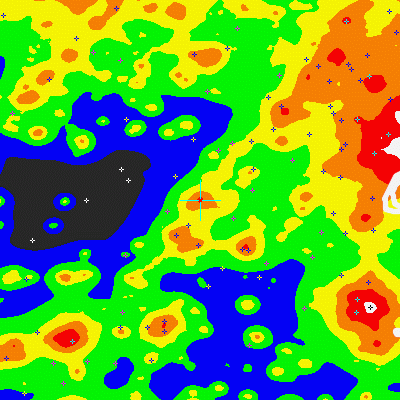How do I read the chart?
Read the image from left to right. Each column represents a different hour. The colors of the blocks are the colors from CMC's forecast maps for that hour. The two numbers at the top of a column are the time. A digit 1 on top of a 3 means 13:00 or 1pm. It's local time, in 24hr format.

Harrisonburg Light Pollution Map
Light pollution limits the visibility of the milky way to the unaided eye, the visibility of nebulae and galaxies seen in telescopes, and raises the noise on CCD astrophotographs. Only the observation of planets and double stars is unaffected. Low light pollution conditions, or dark skies, are the most important properties of a good astronomical observing site.
This map is a small excerpt (180mi east to west, by 230mi north-to-south) from the image of North America from the The World Atlas of the Artificial Night Sky Brightness. The central cross marks the location of the Harrisonburg clear sky chart. Tiny crosses mark other charts. This map assumes an observer at sea level. A real observer should see a slightly darker sky.
For more information about reading this chart, visit cleardarksky.com.
Legend
| Color | Artificial / Natural Sky Brightness |
Sky Brightness mags / sq arcsec V Band |
Bortle Scale approx |
Description (Descriptions are approximate. Your sky may vary.) |
| < 0.01 | 22.00 to 21.99 | 1 | Gegenschein visible. Zodiacal light annoyingly bright. Rising milkyway confuses some into thinking it's dawn. Limiting magnitude 7.6 to 8.0 for people with exceptional vision. Users of large Dobsonian telescopes are very happy. | |
| 0.01 to 0.11 | 21.99 to 21.89 | 2 | Faint shadows cast by milkyway visible on white objects. Clouds are black holes in the sky. No light domes. The milky way has faint extensions making it 50 degrees thick. Limiting magnitude 7.1 to 7.5. | |
| 0.11 to 0.33 | 21.89 to 21.69 | 3 | Low light domes (10 to 15 degrees) on horizon. M33 easy with averted vision. M15 is naked eye. Milky way shows bulge into Ophiuchus. Limiting magnitude 6.6 to 7.0. | |
| 0.33 to 1.0 | 21.69 to 21.25 | 4 | Zodiacal light seen on best nights. Milkyway shows much dark lane structure with beginnings of faint bulge into Ophiuchus. M33 difficult even when above 50 degrees. Limiting magnitude about 6.2 to 6.5. | |
| 1.0 to 3.0 | 21.25 to 20.49 | 4.5 | Some dark lanes in milkyway but no bulge into Ophiuchus. Washed out milkyway visible near horizon. Zodiacal light very rare. Light domes up to 45 degrees. Limiting magnitude about 5.9 to 6.2. | |
| 3.0 to 9.0 | 20.49 to 19.50 | 5 | Milkyway washed out at zenith and invisible at horizon. Many light domes. Clouds are brighter than sky. M31 easily visible. Limiting magnitude about 5.6 to 5.9. | |
| 9.0 to 27.0 | 19.50 to 18.38 | 6 or 7 | Milkyway at best very faint at zenith. M31 difficult and indistinct. Sky is gray up to 35 degrees. Limiting magnitude 5.0 to 5.5. | |
| >27.0 | <18.38 | 8 or 9 | Entire sky is grayish or brighter. Familliar constellations are missing stars. Fainter constellations are absent. Less than 20 stars visible over 30 degrees elevation in brighter areas. Limiting magnitude from 3 to 4. Most people don't look up. CCD imaging is still possible. But telescopic visual observation is usually limited to the moon, planets, double stars and variable stars. |

